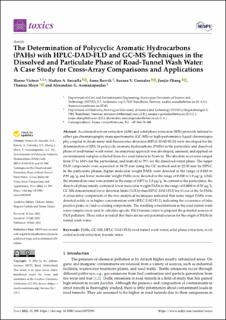| dc.contributor.author | Vistnes, Hanne | |
| dc.contributor.author | Sossalla, Nadine | |
| dc.contributor.author | Røsvik, Anna | |
| dc.contributor.author | Villa Gonzalez, Susana | |
| dc.contributor.author | Zhang, Junjie | |
| dc.contributor.author | Meyn, Thomas | |
| dc.contributor.author | Asimakopoulos, Alexandros | |
| dc.date.accessioned | 2023-01-24T07:55:53Z | |
| dc.date.available | 2023-01-24T07:55:53Z | |
| dc.date.created | 2022-09-12T16:45:06Z | |
| dc.date.issued | 2022 | |
| dc.identifier.citation | Toxics. 2022, 10 (7), . | en_US |
| dc.identifier.issn | 2305-6304 | |
| dc.identifier.uri | https://hdl.handle.net/11250/3045631 | |
| dc.description.abstract | Accelerated solvent extraction (ASE) and solid phase extraction (SPE) protocols tailored to either gas chromatography mass spectrometry (GC-MS) or high-performance liquid chromatography coupled to diode-array and fluorescence detection (HPLC-DAD-FLD) were developed for the determination of EPA 16 polycyclic aromatic hydrocarbons (PAHs) in the particulate and dissolved phase of road-tunnel wash water. An analytical approach was developed, assessed, and applied on environmental samples collected from five road tunnels in Norway. The absolute recoveries ranged from 57 to 104% for the particulates, and from 42 to 79% for the dissolved water phase. The target PAH compounds were separated in 34.75 min using the GC method and in 22.50 min by HPLC. In the particulate phases, higher molecular weight PAHs were detected in the range of 0.043 to 0.93 µg/g, and lower molecular weight PAHs were detected in the range of 0.020 to 1.0 µg/g, while the intermediate ones were present in the range of 0.075 to 2.0 µg/g. In contrast to the particulates, the dissolved phase mainly contained lower molecular weight PAHs in the range of 0.0098 to 0.50 µg/L. GC-MS demonstrated lower detection limits (LODs) than HPLC-DAD-FLD for 13 out of the 16 PAHs. A cross-array comparison of the two analytical techniques indicated that some target PAHs were detected solely or in higher concentrations with HPLC-DAD-FLD, indicating the occurrence of false positive peaks or/and co-eluting components. The resulting concentrations in the road tunnel wash water samples were used to calculate specific PAH forensic ratios to pinpoint the potential sources of PAH pollution. These ratios revealed that there are several potential sources for the origin of PAHs in tunnel wash water. | en_US |
| dc.language.iso | eng | en_US |
| dc.publisher | MDPI | en_US |
| dc.rights | Navngivelse 4.0 Internasjonal | * |
| dc.rights.uri | http://creativecommons.org/licenses/by/4.0/deed.no | * |
| dc.title | The Determination of Polycyclic Aromatic Hydrocarbons (PAHs) with HPLC-DAD-FLD and GC-MS Techniques in the Dissolved and Particulate Phase of Road-Tunnel Wash Water: A Case Study for Cross-Array Comparisons and Applications | en_US |
| dc.title.alternative | The Determination of Polycyclic Aromatic Hydrocarbons (PAHs) with HPLC-DAD-FLD and GC-MS Techniques in the Dissolved and Particulate Phase of Road-Tunnel Wash Water: A Case Study for Cross-Array Comparisons and Applications | en_US |
| dc.type | Peer reviewed | en_US |
| dc.type | Journal article | en_US |
| dc.description.version | publishedVersion | en_US |
| dc.source.pagenumber | 15 | en_US |
| dc.source.volume | 10 | en_US |
| dc.source.journal | Toxics | en_US |
| dc.source.issue | 7 | en_US |
| dc.identifier.doi | 10.3390/toxics10070399 | |
| dc.identifier.cristin | 2050965 | |
| cristin.ispublished | true | |
| cristin.fulltext | original | |
| cristin.qualitycode | 1 | |

